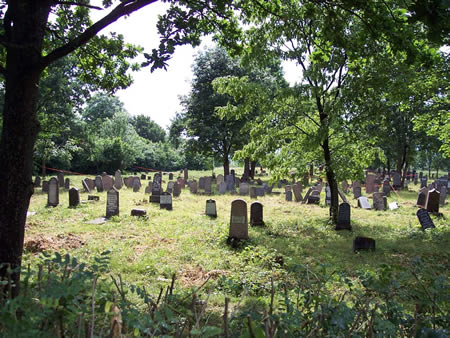|
Old Jewish Cemetery in Lithuania Restored with the Help OF Local Townspeople
By Joel Alpert and Fania Hilelson Jivotovsky
Overview
of the central section of Yurburg Jewish Cemetery
In 2001,
a group of us - twelve descendants of Yurburg, went to visit
Lithuania in search of our ancestral roots. While on a tour in the
capital city of Vilnius, we arranged to meet a local Jewish survivor
Zalman Kaplan who was born and raised in Yurburg. Kaplan shared with
us his memories of the once vibrant Jewish Community in the old but
forgotten Yurburg. He shed a tear remembering the tragic loss of his
family and friends, and told us about life in his beloved native town
that vanished in one day in August 1941. Not a trace of the Jewish
Community was left in Yurburg, except for the old Jewish cemetery,
hidden on a back road of a hill overlooking the Neman river. Aged
stones gave in to the relentless passage of time, overtaken by grassy
impenetrable weeds, the tranquility of the cemetery interrupted by
voices of rowdy teenagers throwing around beer bottles. Some of the
tombstones were gone altogether, stolen or reused by local
construction workers. For Kaplan, then 80 years old, to restore
this unique showcase of the Jewish Community, was a task of utmost
importance, and he feared he would not live long enough to see the
task completed. Zalman had escaped the Nazi invasion of Yurburg on
June 22, 1941, at the start of the Nazi “Operation Barbarosa”
to invade Russian territory. He pedaled his bicycle out of town
barely escaping the advancing German troops behind him. He
ultimately fought the Nazis in the 16th Lithuanian Brigade of the Red
Army composed mostly of Jews. By the end of September 1941, the 1000
Jews who lived in Yurburg before the war were all gone, the majority
of them murdered by the willing local Nazi collaborators in
Lithuania.
Not a
single Jewish person returned to Yurburg after the war, and the
cemetery, standing alone and deserted in the hinterlands of
Lithuania, became the only reminder of the hundreds of years of
Jewish past. Albeit ironically, the tombstones, some of them still
intact, served as proof of the vibrant Jewish life that once was. As
is well known, many Jewish cemeteries in rural towns of Eastern
Europe have been desecrated. Headstones have been removed and
recycled in construction projects or roadways. Many Jewish
cemeteries were redesigned into soccer fields or parking lots. Yet,
this cemetery of Yurburg, in the western back roads of Lithuania with
more than 300 identifiable headstones had miraculously survived. We
could not refuse the urgent request to help Zalman accomplish his
life’s goal.
First, we
set up a not-for-profit organization and called it “Friends of
the Yurburg Jewish Cemetery.” In 2005, we made a second trip
to Yurburg. This time we requested a meeting with members of the
Jurbarkas (the Lithuanian name of Yurburg) town council to discuss
the restoration of the cemetery. Eight of us came into the meeting,
When all was said and done, the town council promised to
cooperate, but admitted they had no money to allocate to a cemetery,
much less to the “Jewish cemetery” They told us that
this was not the first time they were asked to help, yet, as they
stated, “there was never any follow-up”. We sensed an
implied “dare” in their words to actually follow through.
With the
help of other family members and other descendants of Yurburg, the
“Friends” raised $5000. With that money in hand, we
contacted the small Jewish community of Kovno (Kaunas) and asked for
their help to arrange construction of a new entrance gate to
replicate the original one destroyed during the war. Motl Rosenberg,
a son of a Yurburg survivor Dobba Rosenberg, who still lives in
Lithuania, began to work on the design and construction of the new
entrance together with the municipality of Jurbarkas.
The
project became a true test for the “Friends”. Could we
accomplish such a monumental task being so far away from the
restoration project? As time would show, we could, indeed, and the
entrance would be completed in November 2006.
Rejoicing
at our first success, we embarked on another fund raising campaign to
tackle the next task of rebuilding the fence around the cemetery,
Zalman’s ultimate goal. We managed to raise another $15,000.
Then, unexpectedly, help that might have been “b’shert”
came our way.
We
received an e-mail from Rabbi Edward Boraz of Dartmouth College
Hillel in Hanover, New Hampshire who was looking for a site for his
“Project Preservation, 2007”. The project was in its
fourth year in which about 20 students, both Jewish and non-Jewish,
travel to Eastern Europe, visit Auschwitz and spend a week restoring
an old Jewish cemetery in a small town, once home for Jews before
World War II. Rabbi Boraz inquired if he and his group could work on
“the cemetery in Yurburg”. The “Friends” were
elated and welcomed the offer. We hoped that, although the cemetery
was under the jurisdiction of the town municipality, construction of
the fence by American volunteers would be permitted.
In the
summer of 2007, 18 Dartmouth college students along with Rabbi Edward
Boraz, a faculty member of Dartmouth College, Joel Alpert and his
spouse Nancy Lefkowitz of the “Friends” with one more
resident of New Hampshire went to Yurburg for five days to work on
the installation of a 300 meter-wrought iron fence constructed in
Lithuania and designed by Dartmouth Hillel. The group was joined by
eight English class students from the local Lithuanian High School
who came together with their enthusiastic teacher Asta Akutaitiene to
help with the construction project. The American and the Lithuanian
students worked tirelessly to dig up and upright the overturned
headstones covered in mold and layers of thick moss accumulated
through many decades after the war. They dug holes, hauled sections
of the fence and cement to the site to anchor the structures. Even
members of the town council turned up to give a hand in the general
clean up, removing trash and weeds into the trunks of their own
private automobiles. It was a stunning and spectacular sight, and
the spirit of comradeship was overwhelming.
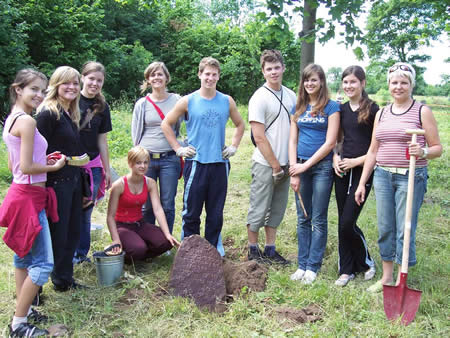
Asta
Akutaitiene (shovel in hand) with the Lithuanian High School students
digging up a long forgotten headstone.
This
joint effort became one of the most important parts of our cemetery
project. It was the first time the Lithuanian students had ever met
any Jewish people. The Lithuanian students bonded with their
Dartmouth counterparts, and both groups took pride in their mutual
work. There was now a common ownership of the amazing project that
restored a forgotten past.
We became
convinced that if these Lithuanian students would ever hear an
anti-Semitic remark they would not let it pass. These students knew –
Jews are not like some of their friends might be telling them.
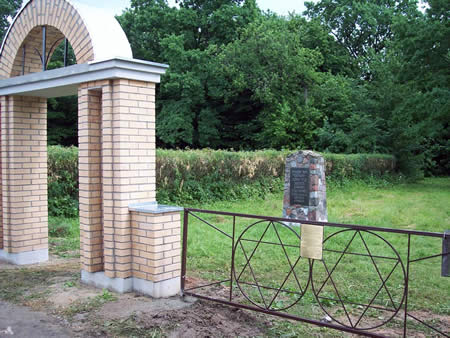
New
entrance 2006 (left) constructed by the “Friends of the Yurburg
Jewish Cemetery” and the new fence (right) constructed by
Dartmouth College Hillel in 2007.
During
their stay in Lithuania, the Dartmouth College Hillel group met two
amazing young Lithuanian women, who helped with the project.
One of
them was Ruta Puisyte, a young Lithuanina woman, a graduate of the
Vilnius State University. She wrote her bachelor’s thesis on
the “Murders in Jurbarkas” because she wanted to learn
more about this hidden part of the Lithuanian history. She once
asked her father about the old cemetery in Yurburg, close to the
village where she grew up. He told her that “horrible things
had happened there”, but would not go into greater detail. She
wanted to know more. Today, she is an expert educator on the history
of Jews in Lithuania and works as an Assistant Director of the
Yiddish Institute of Lithuania.
Officially
Lithuania takes no responsibility for the murder of its Jewish
citizens during the Shoah, in spite of the fact that 95% of the Jews
of Lithuania perished at the hands of Nazi collaborators.
Anti-Semitic remarks are still heard in the country despite the fact
that the Jewish community is very small, numbering only about 3500.
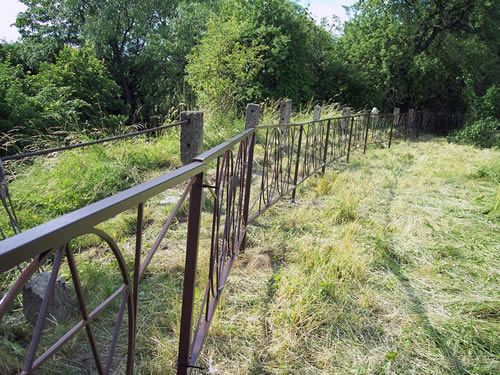
The new
fence with the old decaying Russian era fence behind it.
The
Darmouth College students also met Riva Vaiva, a local Lithuanian
woman who had wanted to learn more about the mysterious inscriptions
carved on Jewish tombstones in the Yurburg cemetery. As a high school
student she would often come to the cemetery on a warm summer day to
read in the shade of an old tree enjoying the tranquility of the
peaceful setting. She began to wonder about this deserted corner of
Yurburg and wanted to know about the people buried in this cemetery.
She looked at the strange markings on the headstones. When she found
out that these were Hebrew letters, she took a course in the Hebrew
Language at the Vilnius University. Over the past years she has
independently undertaken a tedious and artistic task to clean and
re-inscribe the headstones in the cemetery, hoping to help preserve a
page in the history of the Jewish community of Yurburg. Under her
craftsmanship the tombstones now have colorful letters and the
carvings are legible. Rita has taken on an added responsibility to
ensure that the local authorities fulfill their legal obligations to
preserve the cemetery by clearing the bush and tree overgrowth,
cutting the grass and removing trash.
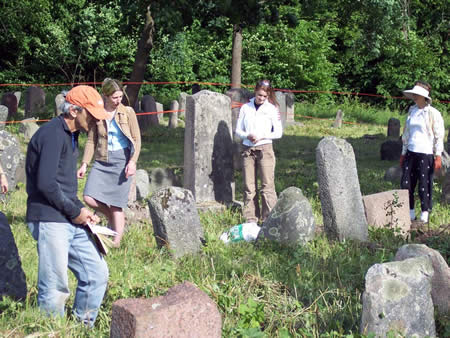
Rabbi Edward Boraz (left) translating headstones, and Riva Vaiva to the right
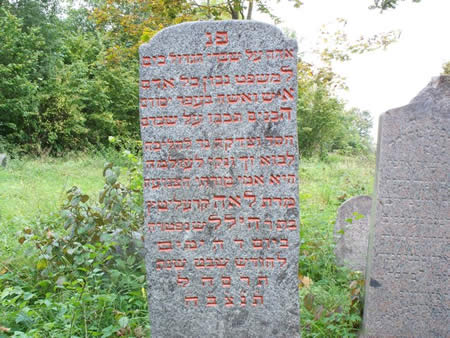
Headstone of Leah
Krelitz, great-grand mother of Joel Alpert re-inscribed by Riva Vaiva
Thanks to
our efforts the Jewish community of Yurburg, tucked away in the
western edge of Lithuania, will not be forgotten. In 2005, the
Memorial to the Murdered Jews of Europe opened in Berlin, the
first such official memorial to the Shoah in the united Germany. In
the Family Fates’ Room of the Information Centre located
beneath the Memorial, there are 15 displays; among them is one about
our Yurburg, featuring the Krelitz family. The display offers many
photos, including the marvelous Wooden Synagogue of Yurburg. A
video clip, restored from a film taken in 1927 reflects a day in the
life of Yurburg in all its vitality which would be destroyed 14 years
later.
The
“Friends” are proud of their accomplishments in Yurburg,
a small town that could have easily been forgotten. We are grateful
that the Jewish Cemetery is being restored and cared for not only by
the Jewish descendants but also by its local Lithuanian residents.
We celebrate the mutual contributions of these two groups that will
promote the healing of the wounds of a horrible past.
Zalman
Kaplan, our landsman from Yurburg died shortly after the project was
completed. It is through the synergy of the young local residents
of Yurburg, and us, the descendants of the town working together with
Rabbi Boraz and the Dartmouth College students that Zalman’s
Kaplan’s life task was finally completed.
We hope
our project will inspire others to contribute to the preservation of
our Jewish past in the small towns of Eastern Europe.
* * * * *
For more articles on Holocaust Jewish History, see our Holocaust Archives
~~~~~~~
from the July 2011 Edition of the Jewish Magazine
|
